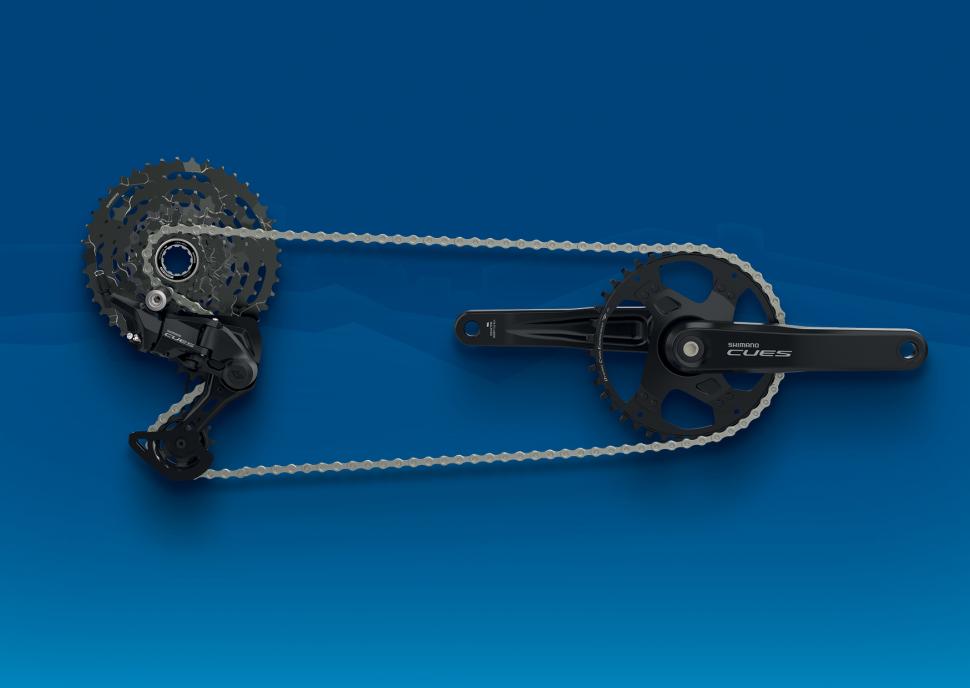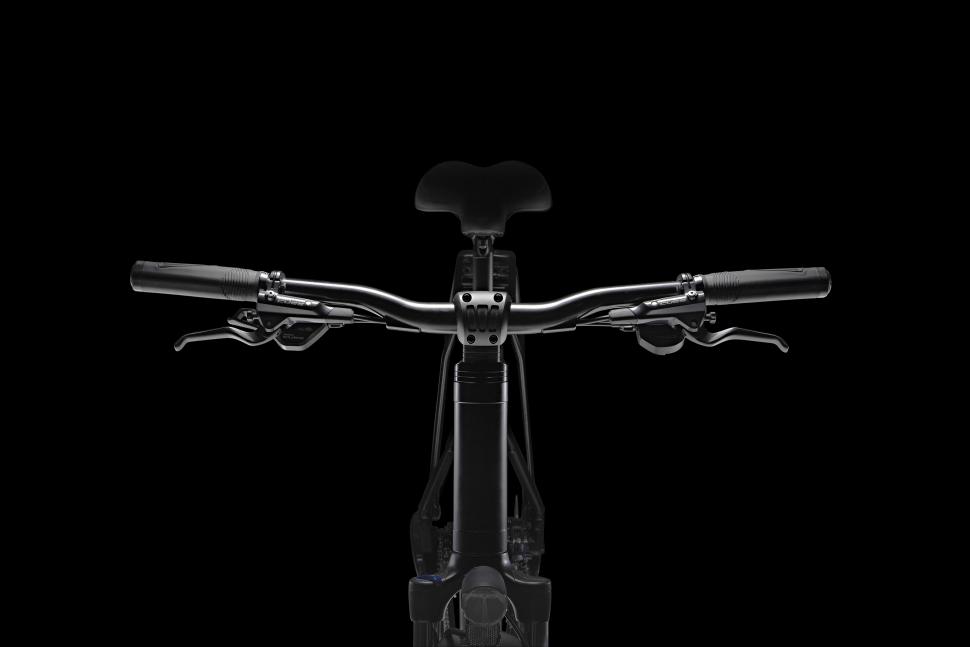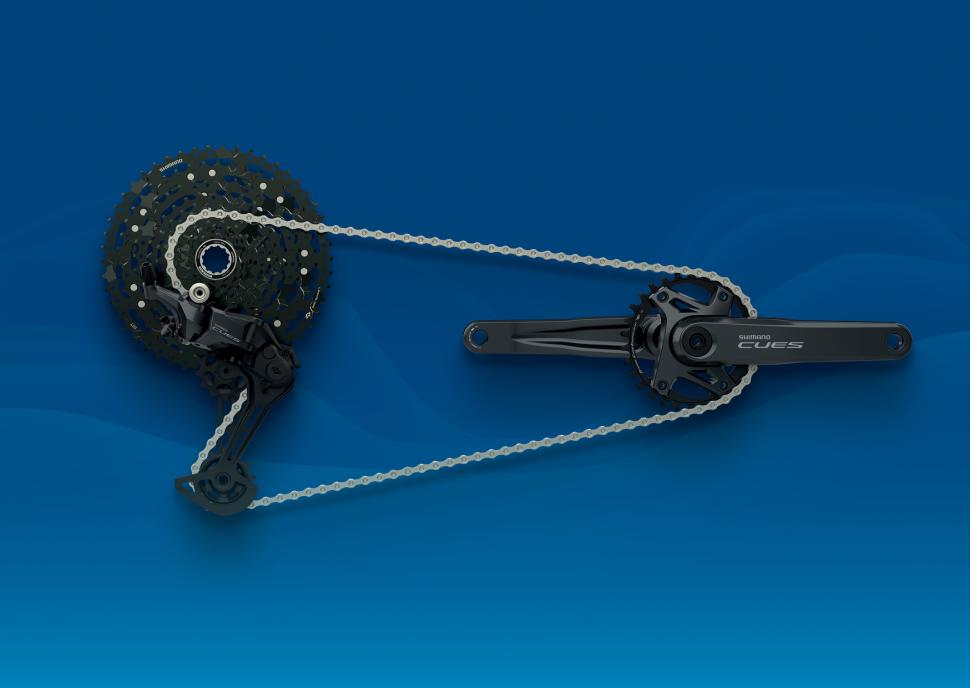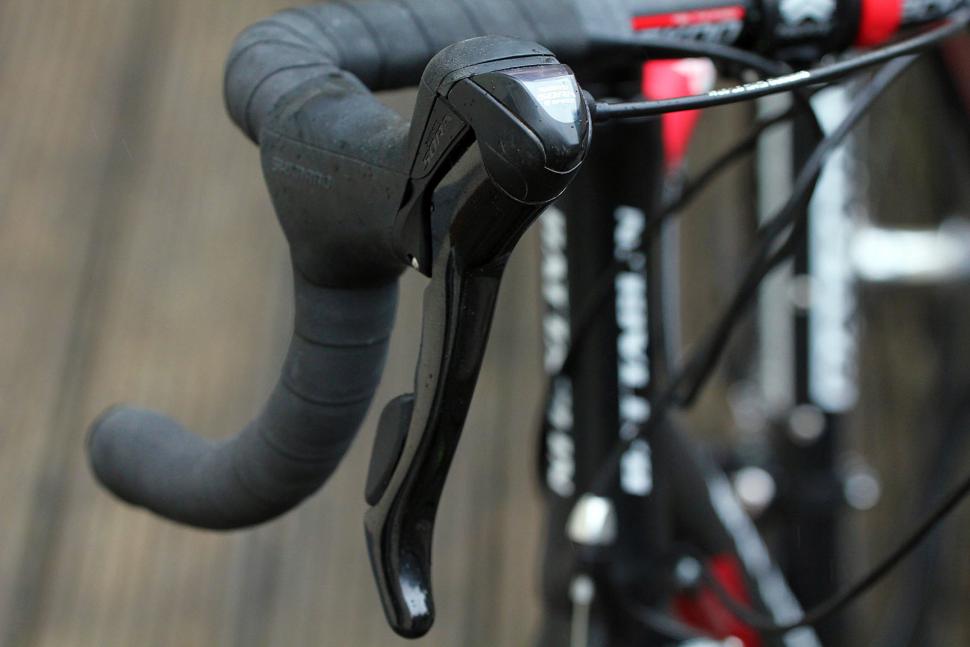- News
- Reviews
- Bikes
- Components
- Bar tape & grips
- Bottom brackets
- Brake & gear cables
- Brake & STI levers
- Brake pads & spares
- Brakes
- Cassettes & freewheels
- Chains
- Chainsets & chainrings
- Derailleurs - front
- Derailleurs - rear
- Forks
- Gear levers & shifters
- Groupsets
- Handlebars & extensions
- Headsets
- Hubs
- Inner tubes
- Pedals
- Quick releases & skewers
- Saddles
- Seatposts
- Stems
- Wheels
- Tyres
- Tubeless valves
- Accessories
- Accessories - misc
- Computer mounts
- Bags
- Bar ends
- Bike bags & cases
- Bottle cages
- Bottles
- Cameras
- Car racks
- Child seats
- Computers
- Glasses
- GPS units
- Helmets
- Lights - front
- Lights - rear
- Lights - sets
- Locks
- Mirrors
- Mudguards
- Racks
- Pumps & CO2 inflators
- Puncture kits
- Reflectives
- Smart watches
- Stands and racks
- Trailers
- Clothing
- Health, fitness and nutrition
- Tools and workshop
- Miscellaneous
- Buyers Guides
- Features
- Forum
- Recommends
- Podcast
TECH NEWS
 2023 Shimano CUES
2023 Shimano CUESShimano unveils new cross-compatible CUES groupsets for city, touring and mountain bikes, consolidating Claris, Sora and Tiagra
Shimano has announced a brand-new approach to its mid-tier component lineup, unifying the 9-, 10- and 11-speed 'lifestyle' lineup under a new product family called CUES. At the moment, CUES is only available for flat-bar bikes, redesigning the existing Claris, Sora and Tiagra groupsets - and mechanical 105 - into a range of interchangeable components, including derailleurs, cassettes and chains. The change also applies to the Altus, Acera, Alivio and Deore MTB drivetrains, which could make sourcing and fitting spare parts for bike shops and riders much less of a headache.
> Opinion: Shimano CUES looks like a genuine game changer
Totally revamping how we’ve come to know the Shimano drivetrain hierarchy, Shimano says that CUES will “offer smoother shifting, more durable components, and standardises compatibility across a wide range of categories” in the brand's lifestyle component lineup. The wide cross-compatibility of the CUES components should mean that repairs and upgrades are easier on CUES-compatible bikes going forward, as shops are not limited by the number of gears on the bike when it comes to replacing or updating components. As we understand it, though, CUES components will not be backwards-compatible with outgoing Tiagra, Sora and so on because the pull ratios are different to the older groupsets.
What is changing?
CUES, (which stands for "creating unique experiences"), is not a totally new concept from Shimano, as we've already seen it launched on the e-bike-specific electronic groupsets last year. Now, the CUES family is consolidating the mechanical mid-tier groupsets, meaning that whereas you previously had a rather clear hierarchy and limited cross-compatibility - between a Sora and Claris groupset, for example - the CUES system should make the mixing and matching of components across speeds much less of a faff.
The CUES lineup modernises the offerings, meaning that some drivetrain options are no longer available and the old groupset options are being phased out. CUES only includes hydraulic disc brake options, and the chainsets are limited to either 1x or 2x setups - meaning there will be no triple chainsets with a granny ring or rim brakes anymore.
Those who are currently running existing 9-, 10- or 11-speed drivetrains on their flat bar bike don't need to panic (yet) though, as Shimano has said the current drivetrain options will stay in the brand's offerings for at least the next seven years as they are being slowly phased out.
> Are we seeing the death of the triple chainset?
CUES will incorporate and discontinue Claris - Shimano's current entry-level 8-speed groupset for road, fitness and touring - as well, but the timeline of all of the changes being rolled out is not clear. This slightly vague launch of CUES can be seen as the introduction of the concept, rather than a definite announcement of groupsets being discontinued.
The CUES lineup
CUES consists of three levels of components across all riding disciplines: U4000, U6000 and U8000. The U4000 range is 9-speed, U6000 is available in both 10- and 11-speed and the U8000 comes with 11-speed components. All of these are cross-compatible, to a certain extent.
You will find all of the CUES groupsets designed to use an 11-speed chain - meaning all of the cassettes have the same spacing between the sprockets and can be run with any existing 11-speed chain - including the e-bike specific E8000 chain that was part of the e-bike CUES launch last year.
How is CUES more durable than previous drivetrains?
The cassettes all feature Shimano’s Linkglide technology - something the brand initially introduced as an alternative to its more premium Hyperglide tech. Whereas Hyperglide is all about lightweight and performance, Linkglide is about durability and in the case of CUES, compatibility and accessible price points, so we're told.
The Linkglide cassettes have a specifically designed, taller and thicker tooth shape that provides additional surface area and mitigates the chain from skipping, especially under heavier loads experienced on e-bikes. The design distributes pedalling forces more evenly to prevent premature wear due to shifts from less experienced cyclists, so in other words, the Linkglide system is very forgiving for gear crunchers.
The CUES Linkglide cassettes fit on a standard HG freehub body and the two smallest sprockets - the 11 and 13-tooth ones - are the exact same across the range so that they can be replaced separately from the rest of the cassette.
Shimano says the lifespan of the Linkglide cassettes is three times longer than that of the alternatives, making them the most durable in the brand's offerings. This obviously makes the Linkglide range more budget-friendly, as well, as you don't have to change the components so often.
Can different speed CUES components be mixed?
All of the CUES shifters and derailleurs use the same, specific Linkglide pull ratio, meaning that yes, the shifters can be used across different speed groupsets.
The CUES drivetrains feature 13-tooth jockey wheels across the range, again making the system more cross-compatible across the 9,10 and 11-speed CUES components. This should make sourcing and fitting spare parts much easier, because all pull ratios and cog spacings are the same.
When can we see CUES on bikes?
The CUES components are not widely available in the UK quite yet, but it's likely that most of the mid-range bikes that you're going to see enter the markets later in 2023 will be equipped with a Shimano CUES groupset instead of the outgoing 9, 10 or 11-speed models.
What about STI levers/drop bar bikes?
This is the first launch of CUES outside the electronic groupsets that were announced last year, and a source tells road.cc that “Shimano have 'have all but confirmed' that CUES componentry for drop bar is coming, but not until much later”.
We're taking this to mean that the CUES treatment, with the phasing out of Tiagra, Sora and Claris, could be coming to road bikes too, although we're not 100% sure if the phasing in and out times are the same as this initial announcement for flat-bar fitness, city and mountain bikes.
And the prices?
At the time of writing, we don't have any pricing information at all for the CUES system or any of the components in the new line-up... so we're unable to judge if it will indeed provide the accessible price points we've been promised right now! You can check out Shimano's website for more details on CUES, and we'll update when we get more information.
Latest Comments
- BikingBud 6 min 53 sec ago
And relevant to the reminiscence of the mini, here we see the reality of the fashion driven size increase in the classic small car.
- mark1a 8 min 36 sec ago
This simply isn't true. I've been running radar lights for 10 years now. I cycle mostly on rural roads, I get notified of approaching vehicles up...
- Rendel Harris 2 hours 38 min ago
Genuinely puzzled as to how you've extrapolated that from what I said. Care to explain?
- Pub bike 4 hours 49 min ago
He is up against the global trading system, which has obviously been in the news a lot lately. Framebuilders in other countries can undercut him,...
- David9694 6 hours 21 min ago
Stouport residents bemoan huge traffic queues through town...
- rookybiker 17 hours 15 min ago
The trailer seems to connect to both ends of the rear axle. Can it do tight corners without dragging the tyre sideways?
- Destroyer666 18 hours 12 min ago
Have you owned Bont shoes? In my experience even the widest Lake shoes have had a bizarre form of narrowing way too much in the toe area. But the...
- froze 18 hours 40 min ago
Not sure if this is possible, but this news letter goes out all over the world, and some places like Decathlon does not send stuff to America, in...






Add new comment
59 comments
What is the obsession of trying to kill off the rim brake? Is it just down to that can charge more money? I get it that hydraulic discs work better but they are harder to maintain and cost more It's crazy that an entry level groupset is not available with the simplest technology.
They don't even work better.
It's crazy that an entry level groupset is not available with the simplest technology
What is the obsession with conspicuously living in the past? Is it now 'cool' to be a 'head-in-the-sand Old Knacker'? Disc brakes are taking over because they're better for us non-racers. Cable discs are much better than rim brakes because they brake better, especially in the wet, and the engineering is simple and cheap. That's good enough for me
They're 'better' for non-racers because they brake 'better'? What does that even mean?
The limit of my stopping power when braking with my rim brakes is my tyre traction, in the dry and even moreso in the wet. I can lock up both wheels easily in dry or wet conditions without much force from my hand with my 105 levers and calipers.
The only thing I have ever noticed when using disc brakes is that I can lock up easier. To me that's a very, very bad thing.
Horses for courses - and the importance of "what's the average (given a not particularly fastidious mechanic and decidedly middle-range parts)?"
A well-adjusted *drum brake* never mind rim brake can lock a wheel. Incautious braking with a disk brake is certainly bad for the unwary. The other side is that I have found the best disc brakes I've used required less effort. That was a good thing when you get tired, or for fine control
Not having wet / dirty braking surfaces is always a good thing. I've run both drum and disk brakes and they both generally retain much more stopping power in the wet / slushy conditions compared to the average canti / V-brakes I've used. (I haven't run kool-stop or other better rim pads).
Once used to them I did find the (not particularly special) *hydraulic* disk brakes to require less effort than my medium to low grade cantis or cable discs (Avid BB7). I've also had a go with hydraulic rim brakes - Maguras - and while that was some time ago and always in the dry I recall them being "good".
I've done very little adjustment to my brakes other than changing parts. I did take a little more time setting up the drum brake cable. I also haven't yet suffered from a warped disc rotor or had air in the lines, both of which will apparently cause you to curse that technology!
Indeed, as if stopping was ever really a problem on road bikes in normal use by average people? For high end bikes with carbon rims, maybe. For super aero bikes with completely concealed cabling, yes I can see why you'd want disks. For downhill mountain bikers, sure.
But for the mass of people, hydraulic disks are overdesign. Cable operated disks, yeah, they work, but they're typically very heavy and need regular adjustment or they can fail catastrophically - see this story. The limit to braking on a bike is quickly reached in a panic stop, due to the tiny contact patch and short wheelbase. The few times in my 58 years of cycling that I've needed to make an emergency stop, the back wheel has locked up then come off the ground. You can't brake harder than that.
Every day I see people cycling to work who are stuck in their highest gear, because they've never bothered to learn how to change gear. They're not going to service hydraulic disks when they get spongy and soft.
That said, standard derailleur pull ratio is a good idea, though it's typical that they've designed it to be incompatible with any existing system. Exactly what you'd expect from a company that deliberately made its chainrings incompatible between ranges for no good reason at all.
If your rear wheel is lifting off the ground, then you have not exceeded the limit of traction on the front tyre, so the wheelbase and weight distribution is more of a limit than the tiny contact patch.
If your front wheel locks and slides out you have breached the traction limit, (and likely had a crash). I have never lost the front wheel in this way with any braking system.
And I agree that in the dry I can brake as hard as I need to with rim brakes
However, sometimes I ride in the rain, or rain happens when I didn't expect it, and in these conditions the brake disc is less affected than the rim.
Amazing the number of people that assert they can lock up their wheels in the wet with rim brakes.
That is far from my experience and even less so with carbon rims. I' am left wondering what rubbish tyres they are using, or maybe they are riding on ice. I have never locked up a wheel using disc brakes except where the wheel is unweighted (by hump in road or weight transference). I have certainly never locked up the front, except as a youth deliberately doing endos.
In addition I do not want my expensive carbon rim to be considered a consumable wearing part as the grit and muck from UK roads is squeezed between pad and rim.
Any time someone wants to come out with me on my local roads with 20% downhills in heavy rain and show they can match braking performance, I'd be most interested.
Traditionalists: rim brakes are just as good, disc brakes are a con
Other traditionalists: disc and rim brakes shouldn't be allowed in the same peloton due to the risks of different braking performance.
you're missing the point. We're taking about cheap starter hybrid bikes here, fitted with the likes of Tourney that many people on low incomes buy to get around and hopefully get a bit fitter. They're currently fitted with v-brakes that are ridiculously cheap, low maintenance and stop you effectively. A hydraulic disc brake set up is ridiculously overkill on a setup like that. It will be hugely more expensive and add another barrier to getting people on bikes. This has to be wrong? Are they seriously just going to offer a Tourney groupset equivalent with hydraulic discs?! It will at least double the price of the groupset.
The lowest Cues groupset will be 9 speed with hydraulic disc brakes; that said, the current groupsets will still be made for several years and I suspect if manufacturers provide a demand for low end 8 speed V-brakes ongoing, Shimano may keep making them.
You say with certainty that they are going to be hugely more expensive and will double the price of a group set. Where have you seen Shimano's price list please?
Do you know how much a full Tourney groupset costs? it's about £100. If the lowest price CUES system is that low, then amazing, I'll take back everything i said.
Can't you see Shimano putting this out at silly discounted prices to get a really firm grasp of the new bike market so as a first time buyer you are locked in to their product then making a tidy profit on replacement parts which in the real world won't make much difference to the consumer, even if something is twice the price of a current Tourney rear mech in real spending terms it won't be too bad. I agree with you that individual parts will probably cost more but to what is probably Shimano's target market the additional cost will be minimal
If a Tourney has an RRP of arond £100 I can very clearly see why Shimano might not want to race to dominate the bottom of the market.
They already dominate most of it, apart from Microshift that are used a bit, at the entry level it's mostly Tourney on entry level hybrids. (Tourney drop bar costs a fair bit more becuase of the Shifters). I wouldn't be suprised if Shimano sell more Tourney than any other groupset.
valid
Not living in the past, I just want a simpler more sustainable life. Rim brakes work, are cheap to buy and maintain. Just because we can have tomatoes in February does not make it the best option... Let's keep life simple.
I'm with Froome on this one (not completely the same reasons). Anyway, the industry has spoken and I'm wrong.
This.
It has been shown that a part from hub dynamos and LED lights, there hasn't been a *real* improvement in bike technology since the 1930s, when bike frames moved to thinwall tubing, only "innovations" i.e. money spinners.
If you enjoy mountain biking or commuting with downtube shifters, you might be right. But although my 1988 steel bike is the comfiest I have, I'm never commuting on it again - braking and shifting without having to move my hands is just so much better.
Please show us your source(s).
Can see some of the touring afficiandos not being best pleased with no 3x crankset....
I'm managing without a triple (Alpine Double is great) and have only just edged one bike up from 7 to 8 speed.
I'm not making Shimano much money I guess!
Makes a lot sense harmonising all those groups, MTB has been a mess with loads of overlap and dubious product differentation for a while now.
Road is a little simpler. Assuming they harmonise in the same way that means we'll have R4000 (8/9 sp?) & R6000 (10/11sp?) replacing Claris, Sora, and Tiagra and then the existing R7000, R8000, and R9000 groups which will likely be electronic only.
FWIW, while Shimano has not publicly confirmed a mechanical 12 speed 105 groupset, it has been seen on some leaked spec sheets for 2024 MY bikes.
If they replace XT with this please can they call it EXCUSE, it would make my brain very happy
CUES will be produced in 1x and 2x variants that will feature 9, 10 and 11-speed cassette options.
You’ll find both 2-piston and 4-piston brake options.
Everything above CUES (that’s Deore, SLX, XT and XTR) will remain as 12-speed.
Any impact to Deore Trekking? Last of the triples afaik.... in flat or drop.
Shimano will continue to make existing groupsets for several years and if there is enough demand for sets like Deore Trekking, they will continue to make parts, if not the groupset for new bikes.
Pages